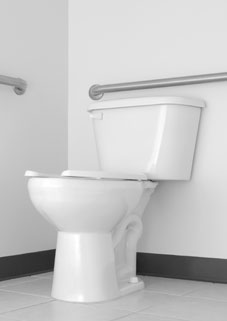Continence: Helping Those with Dementia Find the Toilet at Night
 Continence nurse, Andrea Lord, gives practical tips and ideas to help those experiencing confusion find the toilet in the wee hours!
Continence nurse, Andrea Lord, gives practical tips and ideas to help those experiencing confusion find the toilet in the wee hours!
Question: My dad, who has dementia, has forgotten how to find the loo! Sometimes in the night he wees in the bath, on top of the lid, or even in the handbasin. Mum finds this distressing; she’s 78 and the cleaning and interrupted sleep are getting her down. Is it time for formal care, or are there some practical ways to help dad? Moeroa, Rodney
Answer: This is a common and upsetting issue for those living with someone who has Alzheimer’s or dementia. Finding the loo, and directing urine so it is contained in the bowl, are problems with other conditions too, such as brain injury, strokes, Parkinson’s, various neurological conditions, and vision impairment. We hope our suggestions help your parents and other people manage better. If the confusion persists, don’t assume that formal care is the only answer. Talk to your dad’s GP to rule out whether other issues are causing confusion. You can also get advice from a continence nurse by phoning the national helpline: 0800 650 659.
Andrea’s Advice!
- Keep the toilet door open so it’s easy to find.
- Keep a light on to minimise confusion when it’s dark.
- Have a rough idea of toileting or bladder patterns; taking someone to the toilet when they are less likely to go can itself be confusing.
- As with young children, watch for signs that the person wants to go (pulling at clothing, restlessness, wandering, and so on).
- Use clothing or underwear they recognise and can easily remove. If incontinence is an issue, ‘pull up’ disposable underwear can be pulled up or down like normal underwear (or, if necessary, thrown away).
- Remember, continence is a deeply ingrained social skill, typically one of the last to be lost, so if someone is incontinent, don’t assume it is due to their condition; it may be the result of an infection, medication, constipation, or other cause.
- Avoid waking someone in the night for toileting, as this is tiring and disorientating for all concerned. Ask your GP or continence nurse about products such as uridomes, a sheath that fits over a man’s penis like a condom, and attaches to a disposable drainage bag which can be emptied in the morning. These products can ensure a peaceful sleep, which may reduce confusion.
- Use coloured toilet fresheners to turn the water a bright colour, such as blue. This reminds a confused person of the toilet’s location, and also provides a target for weeing into if eyesight is a problem. You could also place a red towel in the bath to warn the person it is not the toilet.
- If urinating in the handbasin is a problem, try accepting this behaviour. Looking at the shape of men’s urinals, it’s easy to see how this can happen. The basin can be easily sanitised with washing up liquid, antiseptic wipes, or everyday bathroom cleaners.
For dementia advice and support visit the website of Alzheimer’s NZ, www.alzheimers.org.nz
Photo: Shutterstock.com, MilesBoyer